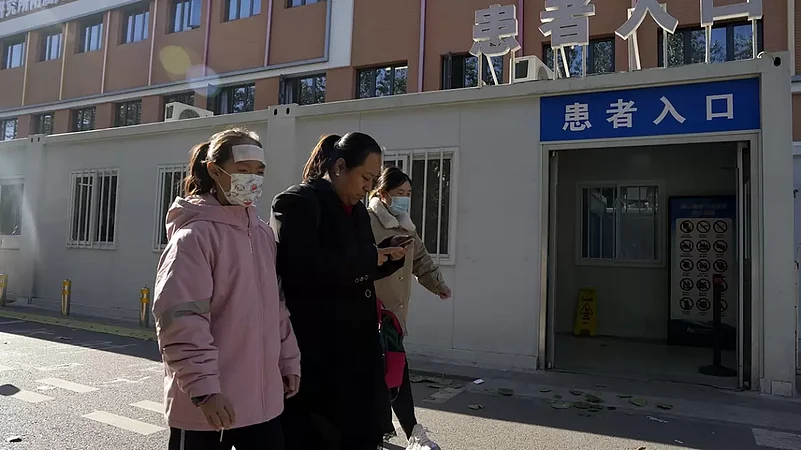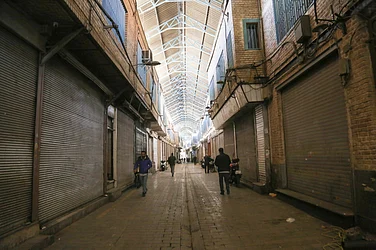For the past few weeks, China has been under a wave of a respiratory illness that has sickened children particularly.
While Chinese authorities attribute the spike in illnesses to the onset of winter season and lifting of Covid-19 restrictions, there is alarm in several quarters as the last time China witnessed such a spike in respiratory illnesses was in 2019. That spike turned out to be the Covid-19 outbreak that plunged the world in a pandemic unseen in living memory and crippled healthcare systems the world over.
The World Health Organization (WHO) has taken cognisance of the situation in China and has sought data from authorities there. While the Chinese authorities have shared data with the WHO, questions are bound to continue to be raised as China has a dubious record in data-sharing as seen regarding the Covid-19 pandemic.
Here we understand what's behind the current outbreak, what are the unaddressed questions, and why people are raising questions at China.
Chinese hospitals overburdened with respiratory illnesses
A wave of respiratory illnesses, initially dubbed as 'mysterious pneumonia' has taken over eastern and northern Chinese regions. Chinese state-media has reported that the internal medicine department at Beijing Children’s Hospital has witnessed 7,000 patients a day, which is above the entire hospital’s capacity.
The illnesses have taken a particularly high toll on children, with reports saying that hospitals have been overburdened. The surge in illnesses was first reported in mid-October, which coincided with the busiest travel season in the country.
A parent of a 7-year-old said that the rush was such that it took them two to three hours just to see the doctor in Beijing.
"It took us two or three hours to see the doctor, whereas normally the wait time is only half an hour. I know four or five families with this situation. I am very worried the virus will keep spreading," said Emma said Wang to NBC News.
NBC further reported that hospitals in Beijing and elsewhere in China were "overwhelmed with sick children" during the current outbreak.
After media reports and an alert by Program for Monitoring Emerging Diseases (ProMED) of the International Society for Infectious Diseases (ISID) flagged this spike, the World Health Organization (WHO) took cognizance of the situation and sought details from Chinese authorities. In its alert, ProMED said there appears to be "undiagnosed respiratory illness in several areas in China" as two places flagged with such spikes are Beijing and Liaoning that are hundreds of kilometres apart. This shows that the outbreak is not localised and is fairly well-spread.
"It is not at all clear when this outbreak started as it would be unusual for so many children to be affected so quickly. The report does not say that any adults were affected suggesting some exposure at the schools," said ProMED in its alert.
Mycoplasma pneumonia, RSV, flu: China lists causes of spike
As reports emerged of a surge in respiratory illnesses in the country, Chinese authorities earlier this month attributed it to seasonal ailments as the winter season has come in the country and the lifting of Covid-19 restrictions. It also listed certain circulating pathogens that are more likely to affect children than adults.
On November 22, the WHO asked China to share details which it shared the next day. Reiterating that no new pathogen was circulating, the Chinese authorities said all the infections were from known bacteria and viruses.
Chinese authorities acknowledged the spike and attributed it to lifting of Covid-19 restrictions and the arrival of the cold season, according to WHO.
The WHO further said that the Chinese said the infections were caused by known pathogens such as influenza (flu), mycoplasma pneumoniae, respiratory syncytial virus (RSV), and SARS-CoV-2, the virus that causes Covid-19 disease. The Chinese added that mycoplasma pneumonia and RSV are known to affect children more than adults, so that would explain the surge among children.
The Chinese authorities further said that mycoplasma pneumonia cases have been surging since May and RSV, adenovirus, and influenza virus since October.
"Some of these increases are earlier in the season than historically experienced, but not unexpected given the lifting of COVID-19 restrictions, as similarly experienced in other countries," WHO quoted Chinese authorities as saying, adding that they further said the surge did not cause any further load on healthcare system, despite reports stating thousands of additional patients were reaching hospitals daily.
Some experts have also said that this might just be the case, as this is the first flu cycle after restrictions have been lifted in China. Francois Balloux of University College London told the Associated Press that China was probably experiencing a significant wave of childhood infections since this was the first winter since lockdown restrictions were lifted, which likely reduced children’s immunity to common bugs.
Unaddressed questions and concerns
Even though China attributes the surge to weather and lifting of Covid-19 restrictions, the trend is not in line with the rest of the world.
While respiratory illnesses have increased this year in China, they have decreased in the rest of the world this year, note four University of New South Wales noted in an article for The Conversation. Citing data for the spread of influenza A and B, SARS-CoV-2, RSV, pertussis (whooping cough), adenovirus and Mycoplasma, they say, "It confirms an increase in respiratory illnesses this year in China compared to the same time last year. In contrast, the same comparison for the world shows a decrease this year compared to last year, which tells us China is indeed experiencing more respiratory illness than expected."
The researchers, however, also note that Chinese authorities have flagged causes and no unknown cause has so far emerged. They, however, also noted that this year bird flu cases in humans have also emerged.
"The virus we are most worried about with pandemic potential is avian influenza, which may mutate to become easily transmissible in humans. China has been an epicentre of avian flu in the past, but the spread of H5N1 has shifted to the Americas, Europe and Africa. Still, this year, China has reported multiple human cases of various avian flu strains, including H3N8, H5N1, H5N6 and H9N2. With large and continual outbreaks in birds and mammals, there is a greater likelihood of mutations and mixing of bird and human influenza genetic material, which could lead to a new pandemic influenza virus," note the researchers in the article.
Moreover, in a discrepancy, while Chinese authorities attribute the surge partially to the onset of winter, they also said the surge was being seen since May.
Epidemiologist Eric Feigl-Ding on Twitter has also raised the possibility of a drug-resistant bacteria at play here as an expert was quoted as saying in state-run China Daily that patients were showing mixed infections, drug resistance, and lobar pneumonia.
There are also concerns about the evidence coming from China as the country's authorities are notorious about hiding the extent of the infections and the nature of pathogens involved. Most notably, the Chinese authorities did not share with the world the genome of the new coronavirus even as they started developing a vaccine for their own people. In their investigative book VIRAL: The Search for the Origin of Covid-19, biologist Alina Chan and science writer Matt Ridley write that while the first genome is understood to have been found by December 27, 2019, it was only published by British scientist Edward C. Holmes on January 11 after it was privately shared with him. Meanwhile, on Januar4, the Chinese had started work on the vaccine.
Throughout the Covid-19 pandemic, China has been accused of covering up the origins of the outbreak and preventing independent investigations into the initial outbreak at Wuhan. Such a recent history invokes scepticism in several quarters about the information coming from China about the current outbreak.


























